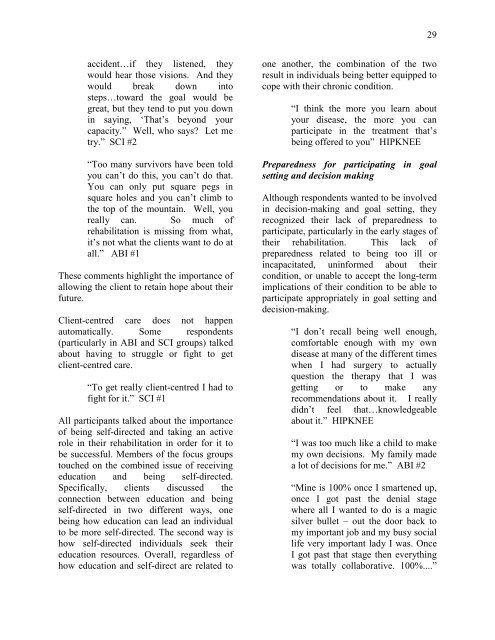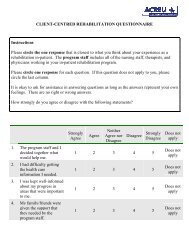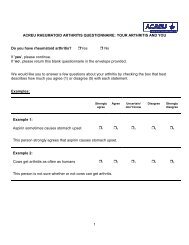Client-Centred Rehabilitation - Arthritis Community Research ...
Client-Centred Rehabilitation - Arthritis Community Research ...
Client-Centred Rehabilitation - Arthritis Community Research ...
You also want an ePaper? Increase the reach of your titles
YUMPU automatically turns print PDFs into web optimized ePapers that Google loves.
29<br />
accident…if they listened, they<br />
would hear those visions. And they<br />
would break down into<br />
steps…toward the goal would be<br />
great, but they tend to put you down<br />
in saying, ‘That’s beyond your<br />
capacity.” Well, who says? Let me<br />
try.” SCI #2<br />
“Too many survivors have been told<br />
you can’t do this, you can’t do that.<br />
You can only put square pegs in<br />
square holes and you can’t climb to<br />
the top of the mountain. Well, you<br />
really can. So much of<br />
rehabilitation is missing from what,<br />
it’s not what the clients want to do at<br />
all.” ABI #1<br />
These comments highlight the importance of<br />
allowing the client to retain hope about their<br />
future.<br />
<strong>Client</strong>-centred care does not happen<br />
automatically. Some respondents<br />
(particularly in ABI and SCI groups) talked<br />
about having to struggle or fight to get<br />
client-centred care.<br />
“To get really client-centred I had to<br />
fight for it.” SCI #1<br />
All participants talked about the importance<br />
of being self-directed and taking an active<br />
role in their rehabilitation in order for it to<br />
be successful. Members of the focus groups<br />
touched on the combined issue of receiving<br />
education and being self-directed.<br />
Specifically, clients discussed the<br />
connection between education and being<br />
self-directed in two different ways, one<br />
being how education can lead an individual<br />
to be more self-directed. The second way is<br />
how self-directed individuals seek their<br />
education resources. Overall, regardless of<br />
how education and self-direct are related to<br />
one another, the combination of the two<br />
result in individuals being better equipped to<br />
cope with their chronic condition.<br />
“I think the more you learn about<br />
your disease, the more you can<br />
participate in the treatment that’s<br />
being offered to you” HIPKNEE<br />
Preparedness for participating in goal<br />
setting and decision making<br />
Although respondents wanted to be involved<br />
in decision-making and goal setting, they<br />
recognized their lack of preparedness to<br />
participate, particularly in the early stages of<br />
their rehabilitation. This lack of<br />
preparedness related to being too ill or<br />
incapacitated, uninformed about their<br />
condition, or unable to accept the long-term<br />
implications of their condition to be able to<br />
participate appropriately in goal setting and<br />
decision-making.<br />
“I don’t recall being well enough,<br />
comfortable enough with my own<br />
disease at many of the different times<br />
when I had surgery to actually<br />
question the therapy that I was<br />
getting or to make any<br />
recommendations about it. I really<br />
didn’t feel that…knowledgeable<br />
about it.” HIPKNEE<br />
“I was too much like a child to make<br />
my own decisions. My family made<br />
a lot of decisions for me.” ABI #2<br />
“Mine is 100% once I smartened up,<br />
once I got past the denial stage<br />
where all I wanted to do is a magic<br />
silver bullet – out the door back to<br />
my important job and my busy social<br />
life very important lady I was. Once<br />
I got past that stage then everything<br />
was totally collaborative. 100%....”








